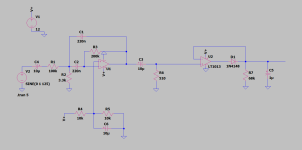Hi, I'm building a 10 band spectrum analyzer based on 10 multiple feedback band pass filters and 10 LM3915's.
Filters have a Q of 4 and 3 . Used Rod elliott's software for multiple feedback band pass filters.
Now, I was thinking I don't need very fast op amps for the band pass filters, maybe for the rectifiers ( peak ) , Chat GPT suggests otherwise.
2.5V ref for the LM3915's , 680R both resistors. So 2.5V max at audio frequencies I think I don't need more then a few V/us slew rate. !?.
Any recommendations for op amps to use ? for the band pass filters and for the rectification ?. I have plenty of 4558 but I think they might be slow , I also have NE5532P , But I can buy any other op amp.
Thank you .
- Bruno.
Filters have a Q of 4 and 3 . Used Rod elliott's software for multiple feedback band pass filters.
Now, I was thinking I don't need very fast op amps for the band pass filters, maybe for the rectifiers ( peak ) , Chat GPT suggests otherwise.
2.5V ref for the LM3915's , 680R both resistors. So 2.5V max at audio frequencies I think I don't need more then a few V/us slew rate. !?.
Any recommendations for op amps to use ? for the band pass filters and for the rectification ?. I have plenty of 4558 but I think they might be slow , I also have NE5532P , But I can buy any other op amp.
Thank you .
- Bruno.
Attachments
-
 bandpass peak.PNG21.4 KB · Views: 88
bandpass peak.PNG21.4 KB · Views: 88 -
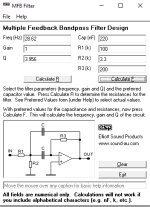 A28-31.PNG14.3 KB · Views: 75
A28-31.PNG14.3 KB · Views: 75 -
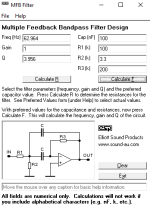 63.PNG13.9 KB · Views: 68
63.PNG13.9 KB · Views: 68 -
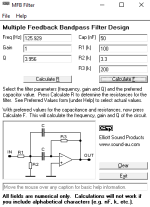 125.PNG14 KB · Views: 60
125.PNG14 KB · Views: 60 -
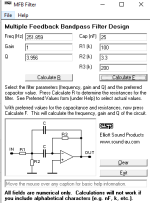 250.PNG14.2 KB · Views: 56
250.PNG14.2 KB · Views: 56 -
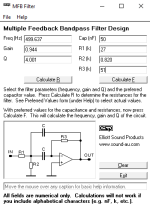 500.PNG14.1 KB · Views: 60
500.PNG14.1 KB · Views: 60 -
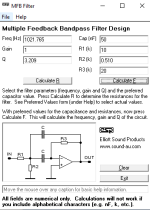 1k.PNG14.2 KB · Views: 57
1k.PNG14.2 KB · Views: 57 -
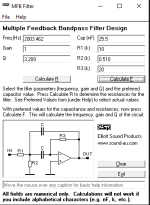 2k v2.PNG13.9 KB · Views: 53
2k v2.PNG13.9 KB · Views: 53 -
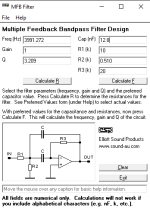 4k.PNG14 KB · Views: 54
4k.PNG14 KB · Views: 54 -
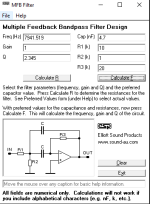 8k.PNG14 KB · Views: 57
8k.PNG14 KB · Views: 57 -
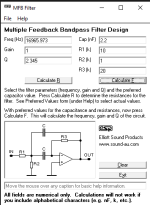 16k.PNG13.9 KB · Views: 79
16k.PNG13.9 KB · Views: 79
It may function without it, but not accurately without the decoupling.
The virtual center reference voltage in a single supply circuit must always be decoupled to ground.
But R2 can go directly to ground. Just the non-inverting input goes to V+/2.
Also don't forget the local main supply decoupling.
The virtual center reference voltage in a single supply circuit must always be decoupled to ground.
But R2 can go directly to ground. Just the non-inverting input goes to V+/2.
Also don't forget the local main supply decoupling.
That cap reduces the DC gain to unity (+1), to minimize the output DC offset voltage.
Which is a different purpose than the "virtual ground" cap in your active filter circuit.
The "virtual ground" active filter cap could be replaced by a battery of half the supply voltage instead.
The battery would (nearly) be a short circuit for AC signals as well.
Not the other cap though. That one is intended to provide an open circuit at DC.
Which is a different purpose than the "virtual ground" cap in your active filter circuit.
The "virtual ground" active filter cap could be replaced by a battery of half the supply voltage instead.
The battery would (nearly) be a short circuit for AC signals as well.
Not the other cap though. That one is intended to provide an open circuit at DC.
Damn, I made a mistake, when I added the voltage divider on the + input. R2 should go straight to ground . I wonder how it worked tho, R3 wasnt 3.3k anymore since its in series with R5 to ground .But R2 can go directly to ground. Just the non-inverting input goes to V+/2.
- This is how it should be right?
Attachments
@raymaI wonder how it worked tho
It sounds good only on low volume , I guess because the missing cap ( in LTSpice the vaweform is triangular without it ) . and R3 not directly to ground.
Any recommendation for the filters Q , 4 seems to be letting to much other frequencies , so may be a Q of 10, I might need to try.
Besides the Q , what order is this filter, 2nd order 12dB ?.
The higher input impedance will give you less voltage droop in the sample hold type section of the circuit with U2.
Cost vs performance !!
It is hard to beat them in many cases such as this one.
Unless you are feeding a +16bit ADC, they are much much better than any JRC opamp I have ever used tested and swapped out.
In the past I also had an issue with using a NE5532 in a filter sections on my Fostex 454 mixer , this was due to the resistors were to high for the BJT type of opamps in the filter sections and would oscillate, so I used the NE5532 in the main direct chain and TL082's for the filters and all was nice and quite with no squealing filters .
jer 🙂
Cost vs performance !!
It is hard to beat them in many cases such as this one.
Unless you are feeding a +16bit ADC, they are much much better than any JRC opamp I have ever used tested and swapped out.
In the past I also had an issue with using a NE5532 in a filter sections on my Fostex 454 mixer , this was due to the resistors were to high for the BJT type of opamps in the filter sections and would oscillate, so I used the NE5532 in the main direct chain and TL082's for the filters and all was nice and quite with no squealing filters .
jer 🙂
So what's the best current contenders for replacing the 4558? I'm debating trying it in a xover.
DD
DD
The jrc4560 were the first to make me smile, in fact I think my Mackie 32-8 may be loaded with them IIRC , I forget.
I would have to look that up.
But every version below that I have never been impressed with.................
I have an old Yamaha MC1202 that is loaded with them (4558's) and the my as measured noise floor of that machine is only in the order of -72db to -68db and higher and at best -78db once with everything zeroed out.
However, if the gain structure is set just right it passes a very nice signal but try to get more out of it and the noise comes up and things get dirty fast !!
I was so fumbled about this I put a scope on it and sure enough it starts to distort noticeably at anything approaching 3Vpeak and above.
I didn't write down the data but I plan on investigating this again and make a thread maybe on it for the last time about the JRC's, before I strip the last of them out and put something better in it.
It was Night and day when I stripped them out of my Fostex454 and put in TL082's and NE5534, it gave the then brand New and Award Winning Mackie32-8 design a run for the big bucks I paid for it in 1994, this was all back then 1993-4!!
I never used another type of opamp since then for anything else until about 2011-12 or so and got some samples of the latest stuff, Awesome parts, but can be very pricey.
When I do redo that MC1202 I will retest it before and after, but, It Is gonna get some OPA16xx if I can't find anymore more modern PDIP's like the LM4560's or LME49xxx, or something I have some here but I need like 50 of them for that board, else its gonna be fun making all those little adapter boards for them as well.
So considering your chip count I just bought 60 TL084's a while back for a $.25 a piece I have even seen NE5534's that cheap as well just gotta get some!!
Price/performance, if you are even just feeding an 8 bit D/A none of those high dollar opamp's will make any difference in performance, the noise floor on the MC1202 was so high that I could not even get a jrc 4558 THD spec'd THD measurment reading using VA and WaveSpectra RTA's with my EchoSystems GINA24 sound card.
An opamp that is supposed to maybe some where about -80db THD or better.
The noise floor and THD on that Mackie today, is exactly as spec'd in the manual on my measuring tools, so no issues there. 😉
So not to be off topic with the above but that is my past 30 something past years experience with the JRC's.
I have made these statements and told this story many years back right here in this forum.
Since you are using it as a measuring tool you will have to weigh out those factors as to if the noise floor is low enough for your goals, in this case I am sure that they are, I only stress that you watch the level of the signal it is producing and since it isn't something that will be heard it is not an issue with noise, as even this is way below the voltage threshold in the first comparator in a LM3915 and the peak voltage an be made to never exceed the 2Vpeak for the Top LED no matter how many steps you have.
FWIW
jer 🙂
I would have to look that up.
But every version below that I have never been impressed with.................
I have an old Yamaha MC1202 that is loaded with them (4558's) and the my as measured noise floor of that machine is only in the order of -72db to -68db and higher and at best -78db once with everything zeroed out.
However, if the gain structure is set just right it passes a very nice signal but try to get more out of it and the noise comes up and things get dirty fast !!
I was so fumbled about this I put a scope on it and sure enough it starts to distort noticeably at anything approaching 3Vpeak and above.
I didn't write down the data but I plan on investigating this again and make a thread maybe on it for the last time about the JRC's, before I strip the last of them out and put something better in it.
It was Night and day when I stripped them out of my Fostex454 and put in TL082's and NE5534, it gave the then brand New and Award Winning Mackie32-8 design a run for the big bucks I paid for it in 1994, this was all back then 1993-4!!
I never used another type of opamp since then for anything else until about 2011-12 or so and got some samples of the latest stuff, Awesome parts, but can be very pricey.
When I do redo that MC1202 I will retest it before and after, but, It Is gonna get some OPA16xx if I can't find anymore more modern PDIP's like the LM4560's or LME49xxx, or something I have some here but I need like 50 of them for that board, else its gonna be fun making all those little adapter boards for them as well.
So considering your chip count I just bought 60 TL084's a while back for a $.25 a piece I have even seen NE5534's that cheap as well just gotta get some!!
Price/performance, if you are even just feeding an 8 bit D/A none of those high dollar opamp's will make any difference in performance, the noise floor on the MC1202 was so high that I could not even get a jrc 4558 THD spec'd THD measurment reading using VA and WaveSpectra RTA's with my EchoSystems GINA24 sound card.
An opamp that is supposed to maybe some where about -80db THD or better.
The noise floor and THD on that Mackie today, is exactly as spec'd in the manual on my measuring tools, so no issues there. 😉
So not to be off topic with the above but that is my past 30 something past years experience with the JRC's.
I have made these statements and told this story many years back right here in this forum.
Since you are using it as a measuring tool you will have to weigh out those factors as to if the noise floor is low enough for your goals, in this case I am sure that they are, I only stress that you watch the level of the signal it is producing and since it isn't something that will be heard it is not an issue with noise, as even this is way below the voltage threshold in the first comparator in a LM3915 and the peak voltage an be made to never exceed the 2Vpeak for the Top LED no matter how many steps you have.
FWIW
jer 🙂
- Home
- Design & Build
- Parts
- OP-AMP Recommendations
